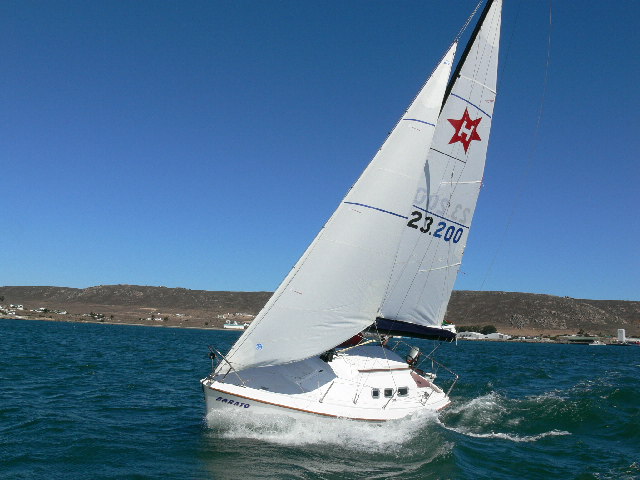 |
| H23 with a reef in, enjoying a bit of a breeze at Saldanha I think. |
 |
| A neat Holiday 23, perfect for Langebaan! |
 |
| Extraordinarily spacious "liveaboard" interior. Well thought out galley, with two-burner plus icebox. Standing headroom (nearly). |
Brilliantly conceived (Jerrold Salomon), brilliantly designed (Angelo Lavranos), and very well built (John Robertson). The link on "Jerrold Salomon" is a good read and directs to the H23 Class Association website. A huge amount of thought went into this concept and design, and it shows in the product. The design brief went something like this:
- Be able to tow it legally behind a car with engine strength of 2.5L or more
- It must have a lift keel
- The average person must be able almost stand up straight in the boat
- Proper Bellamy mast and boom
- North Sails
- Heads
- Storage space for a cooler box
- Ample storage for mooring lines, etc.
- Price at that of an average family car
- Woodwork inside had to be teak with proper cushions for the bunks.
 |
| Clean and simple. Fractional Bermudan rig. Transom mounted rudder adds space all round. |
 |
| Retractable keel. Rudder is cassette mounted on the transom and can be raised. Two plate gas burner, Portaloo. Enclosed V-berth up front. Easily powered with 5-15 h.p. outboard. More info on www.holiday23.co.za |
Building of the first H23 started in 1983. By 1991, 189 had been produced, and the class is still very active in various parts of South Africa, including the Gariep Dam (Vaal), Hartebeespoort Dam, Langebaan, Port Owen, Theewaterskloof, Knysna, Richards Bay etc. Quite a few can be spotted in False Bay and Table Bay on occasion. They tend to move around quite a bit - being easily trailerable.
Sailing performance is surprisingly good in lighter and moderate conditions. They handle well and are easy to sail. In fresh conditions they want to be well reefed with crew on the rail, but will still "get you home" without much trouble.
A common question about small boats is what kind of passage they would be good for? This all depends on who you ask! Anthony Steward (who circumnavigated in a 19' open boat) tends to answer this differently from normal people, but in truth it depends largely on the skipper. Having said that, The Holiday 23 would be regarded as a bit light for true offshore passages, or the Cape South Coast, but I would say quite suitable for short coastal hops from say False Bay to Langebaan in reasonable conditions. The size and ballast ratios etc make it ideal for estuaries and bays, with occasional coastal passages.
 |
| Low and snug on the custom trailer. Easy towing and easy launching/recovery. A four-wheel trailer is a blessing, and insurance against failed wheel-bearings. |
 |
| V-berth up front, enclosed. |
For me, the most outstanding feature of the H23 is just how liveable it really is. It's hard to explain unless you go inside one - the neatly moulded interior is very pleasant, spacious and comfortable. You really have everything you need in a minimalist sort of way. For a couple, this would be a very good option in areas with decent waterways, and the shoal draft and demountable rig would make it very suitable for river or canal cruising too.
In South Africa, sailing boats under 9 metres LOA do not require a licensed skipper, nor the annual Certificate of Fitness rigmarole (unless your club has deemed it necessary to implement their own version of the CoF (grrrr)).
Used H23s often come on the market in SA between R100-200k, and are generally in sound condition. Very little osmosis recorded on these hulls due mostly to good build quality, plus they have often spent time out of the water. A bit of easy maintenance will usually get them well serviceable again, and the outboard makes it so much easier too.
All in all, an affordable, easy to own, very versatile boat offering loads of fun!
 |
| Comfortable, uncluttered and protected cockpit. |
- LOA 7.0m
- LWL 6.0m
- Beam 2.5m
- Draft (keel down) 1.65m (keel up) 0.5m
- Displacement 1300 kg
- Ballast 373 kg (iron)
- Sail Areas Main 12 sq.m, #1 Genoa 16 sq.m


















